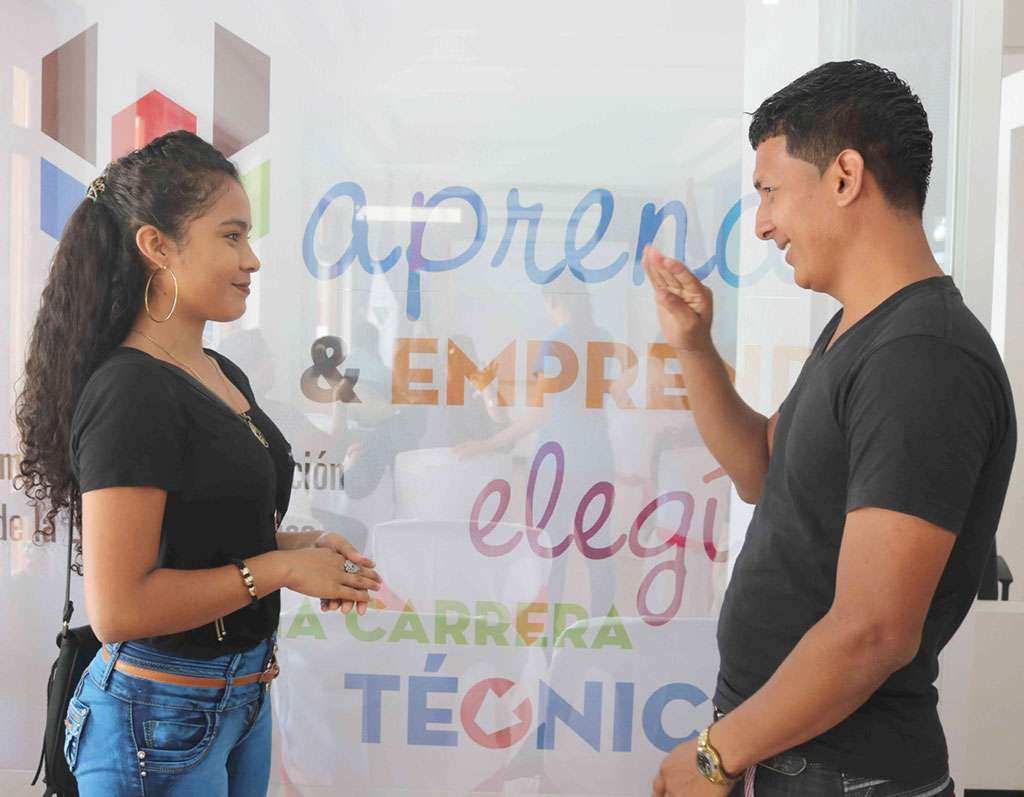BLUEFIELDS, Nicaragua – Growing up deaf in a remote community in the Caribbean Coast region, Cheysi Smith lived in her own world. Like many deaf and hard of hearing children here, she was not taught sign language and was deprived of an opportunity for education.
When she was finally given the chance to learn and entered first grade at age 12, through an organization supporting deaf and hard of hearing children, she seized it.
Today, 27-year-old Smith is a pioneer. With a cohort of six other deaf and hard of hearing students, she is demanding access to higher education through a three-year technical degree in Administrative Sciences at the University of the Autonomous Regions of the Nicaraguan Caribbean Coast (URACCAN).
"It’s important to tell [deaf and hard of hearing] kids that they can come into the universities and [the instructors] can teach us." Cheysi Smith, member of the first class of deaf and hard of hearing students at URACCAN. (Cheysi is pictured on the left in the photo above.)
“Coming to the university was very difficult, so we asked for an interpreter to come to the university,” she says. “It’s important to tell [deaf and hard of hearing] kids that they can come into the universities and [the instructors] can teach us.”
While staff at the university were eager to embrace the students, they lacked skills to communicate with them. To answer this need and help train higher education instructors to work with students like Smith, the university reached out to the Technical Vocational Education and Training Strengthening for At-risk Youth project, known in Spanish as “Aprendo y Emprendo.”

The project, which is funded by the U.S. Agency for International Development and implemented by Creative Associates International, teamed up with certified Nicaraguan sign language interpreters to offer a 40-hour course for 13 university and technical and vocational faculty on how to communicate with and educate students with hearing disabilities.
“We learned that there are 60 deaf and hard of hearing people just in Bluefields, and they didn’t have any access to higher education because they need to have someone to guide them through the process,” says Anne Largaespada, Organizational Development Specialist with the project. “So Aprendo y Emprendo took up the challenge to create a bridge for the deaf and hard of hearing community to technical or higher education because that is what they want.”
Trainees come from University of the Autonomous Regions of the Nicaraguan Caribbean Coast (URACCAN), the Bluefields Indian and Caribbean University (BICU), and the Foundation for the Autonomy and Development of the Atlantic Coast of Nicaragua, (FADCANIC), which operates several technical and vocational training institutes.
The course covers regulations on educational access, a history of challenges faced by the deaf and hard of hearing community, specific educational techniques for the deaf and hard of hearing and hands-on sign language training.
A new language for instructors, a shared goal
In a packed room at Aprendo y Emprendo’s Bluefields office, thirteen educators are communicating back and forth, but the room is silent. With Nicaraguan sign language dictionaries on their desks, the trainees tentatively sign to their colleagues, slowly getting more comfortable with this brand new language.
“This is a new language we are learning so we can get to know these students and communicate with them. They are very special and they have a different world. We need to know what they feel, so that we can help them,” says Francisco Dans, Director and instructor of Administrative Sciences, a technical degree, at URACCAN.
TVET & university instructors learn how to teach hearing-impaired students in #Nicaragua w/@aprendoyempren2 @YPLearning @USAIDNicaragua pic.twitter.com/1P8chlWlk6
— Creative (@1977Creative) March 28, 2017
Dans (above on left in the video), a 31-year-old educator, has been teaching for six years, but this is the first semester he will work with deaf and hard of hearing students, welcoming six into his class.
The three-year technical degree was the preferred choice for these students, most of whom are older than their hearing peers entering university and are eager to gain hard skills that can land them a job.
While learning this new language is a challenge, Dans says he and his colleagues are committed to meeting the students’ needs and opening doorways to careers of their choice.
“They want to study IT and so we, as a university, said we are going to open the university to these students,” he says, noting that the school aims to expand course offerings to deaf and hard of hearing students further in the future.
Like Dans, educators in this training say this is just the beginning of a big change in educational access for deaf and hard of hearing students in their region, even in the most remote communities.
Ofelia Suazo, an educator at a technical institute supported by the Foundation for the Autonomy and Development of the Atlantic Coast of Nicaragua, says she plans to bring her new skills back to her colleagues at their remote institute, a two-hour boat trip from Bluefields.
“We are all committed to replicate this and repeat it, to pass it along to all of our coworkers because there is a huge need. We will have to grow our knowledge,” she says.
‘I can’t imagine’ life without education
For this remarkable group of seven first-time university students, paving the way for future generations of deaf and hard of hearing youth, the road continues to be uphill.
“Now we are at the university, and there are some difficult things and we have to be very patient,” says 29-year-old Iris Omeir, a deaf student at URACCAN. “The most important thing is to keep going.”
She jokes that her arm aches since she does most of the signing while her teachers are slowly learning her language. But despite this she is very optimistic. “It will be an experience for the future to prepare for other deaf and hard of hearing children.”
When asked what her life would have been like without education, Omeir responds, “I can’t imagine.”
In fact, stories like that of her classmate Cheysi Smith, who did not enter school or learn sign language until age 12, are common here. In the Caribbean Coast region, there are few resources for children and youth with a hearing impairment.
“Many of them drop out of high school,” says Largaespada of Aprendo y Emprendo, noting the effects of social isolation and a lack of educational support or interpreters. “We have also learned that they are sometimes victims of violence from their families or that they are abandoned.”

Smith recounts the story of three deaf and hard of hearing people in her community who never got the chance to learn, including one young mother of three children with whom she can’t communicate.
“She is a person inside herself,” says Smith.
But the university has opened a new world of opportunities for Smith and her classmates, and they hope it will do so for future generations of deaf and hard of hearing students.
“Our feelings on being the first in the universities…well, you feel chosen because you were able to finish high school,” says 24-year-old Juan Pablo Perez. “Sometimes we feel shy and some people are more advanced than us, but we can keep going.”
Though they are just beginning their university studies, the group is already looking toward the future and graduating with a technical degree and skills they can use to secure jobs.
“I want to improve my life, to study and progress and in the end to have a good job,” says 17-year-old Shayra Morales, among the youngest of the students.
She knows firsthand the effort and grit it takes to reach this level of education as a deaf or hard of hearing student, but she advises others to work hard, go to university and “do not give up your dreams.”
With reporting by Gretchen Robleto
